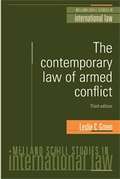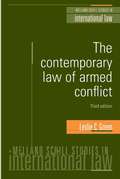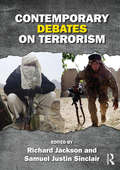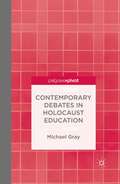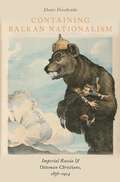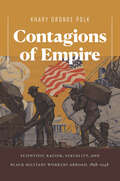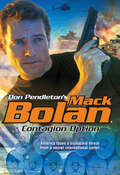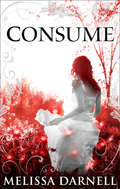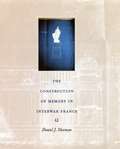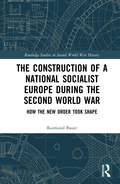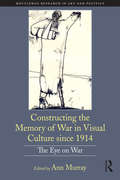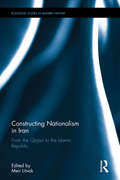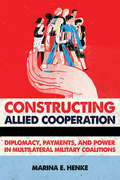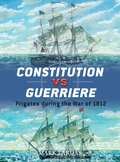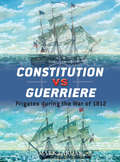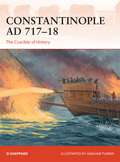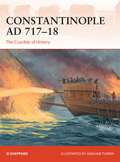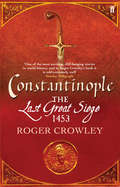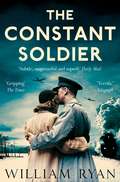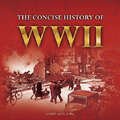- Table View
- List View
The Contemporary Law of Armed Conflict (Melland Schill Studies In International Law)
by Leslie GreenGreen’s The contemporary law of armed conflict has been acclaimed as one of the most significant works on the law of armed conflict to appear in recent years. The first edition was adopted as a basic text by military institutions and educational establishments throughout the world and is among the most comprehensive and readable works on the subject. This new edition brings the work up to date, examining the significance of the World Court’s Opinion on the legality of the nuclear weapon. It also considers the importance of such matters as the laser weapon agreement, the mines treaty and the jurisprudence of the two war crimes tribunals, that for the former Yugoslavia as well as for Rwanda, and assesses the role of the proposed International Criminal Court as it may affect the law of armed conflict. The book applies a practical as well as a theoretical approach, and draws on an extensive range of national and international practice. It is thus an indispensable reference for the armed forces and government defence organizations, as well as academics and students interested in the modern law of war.
The contemporary law of armed conflict: Third Edition (Melland Schill Studies in International Law)
by Leslie C. GreenGreen’s The contemporary law of armed conflict has been acclaimed as one of the most significant works on the law of armed conflict to appear in recent years. The first edition was adopted as a basic text by military institutions and educational establishments throughout the world and is among the most comprehensive and readable works on the subject. This new edition brings the work up to date, examining the significance of the World Court’s Opinion on the legality of the nuclear weapon. It also considers the importance of such matters as the laser weapon agreement, the mines treaty and the jurisprudence of the two war crimes tribunals, that for the former Yugoslavia as well as for Rwanda, and assesses the role of the proposed International Criminal Court as it may affect the law of armed conflict. The book applies a practical as well as a theoretical approach, and draws on an extensive range of national and international practice. It is thus an indispensable reference for the armed forces and government defence organizations, as well as academics and students interested in the modern law of war.
Contemporary Debates on Terrorism (PDF)
by Richard Jackson Samuel Justin SinclairContemporary Debates on Terrorism is an innovative new textbook, addressing a number of key issues in contemporary terrorism studies from both 'traditional' and 'critical' perspectives. In recent years the terrorism studies field has grown significantly, with an increasing number of scholars beginning to debate the complex dynamics underlying this category of violence. Within the broader field, there are many identifiable controversies and issues which divide scholarly opinion, a number of which are discussed in this text: Theoretical issues, such as the definition of terrorism and state terrorism; Substantive issues, including the threat posed by al Qaeda and the utility of different responses to terrorism; Ethical issues, encompassing the torture of terrorist suspects and targeted assassination The format of the volume involves a leading scholar taking a particular position on the controversy, followed by an opposing or alternative viewpoint written by another contributor. In addition to the pedagogic value of allowing students to read opposing arguments in one place, the volume will also be important for providing an overview of the state of the field and its key lines of debate. Contemporary Debates on Terrorism will be essential reading for all students of terrorism and political violence, critical terrorism studies, critical security studies, security studies and IR in general.
Contemporary Debates in Holocaust Education
by M. GrayHolocaust education is a rapidly evolving and controversial field. This book, which critically analyses the very latest research, adopts a global perspective and discusses a number of the most important debates which are emerging within it such as teaching the Holocaust without survivors and the role of digital technology in the classroom.
Containing Balkan Nationalism: Imperial Russia and Ottoman Christians, 1856-1914 (Religion and Global Politics)
by Denis VovchenkoContaining Balkan Nationalism focuses on the implications of the Bulgarian national movement that developed in the context of Ottoman modernization and of European imperialism in the Near East. The movement aimed to achieve the status of an independent Bulgarian Orthodox church, removing ethnic Bulgarians from the jurisdiction of the Patriarchate of Constantinople. This independent church status meant legal and cultural autonomy within the Islamic structure of the Ottoman Empire, which recognized religious minorities rather than ethnic ones. Denis Vovchenko shows how Russian policymakers, intellectuals, and prelates worked together with the Ottoman government, Balkan and other diplomats, and rival churches, to contain and defuse ethnic conflict among Ottoman Christians through the promotion of supraethnic religious institutions and identities. The envisioned arrangements were often inspired by modern visions of a political and cultural union of Orthodox Slavs and Greeks. Whether realized or not, they demonstrated the strength and flexibility of supranational identities and institutions on the eve of the First World War. The book encourages contemporary analysts and policymakers to explore the potential of such traditional loyalties to defuse current ethnic tensions and serve as organic alternatives to generic models of power-sharing and federation.
Containing Balkan Nationalism: Imperial Russia and Ottoman Christians, 1856-1914 (Religion and Global Politics)
by Denis VovchenkoContaining Balkan Nationalism focuses on the implications of the Bulgarian national movement that developed in the context of Ottoman modernization and of European imperialism in the Near East. The movement aimed to achieve the status of an independent Bulgarian Orthodox church, removing ethnic Bulgarians from the jurisdiction of the Patriarchate of Constantinople. This independent church status meant legal and cultural autonomy within the Islamic structure of the Ottoman Empire, which recognized religious minorities rather than ethnic ones. Denis Vovchenko shows how Russian policymakers, intellectuals, and prelates worked together with the Ottoman government, Balkan and other diplomats, and rival churches, to contain and defuse ethnic conflict among Ottoman Christians through the promotion of supraethnic religious institutions and identities. The envisioned arrangements were often inspired by modern visions of a political and cultural union of Orthodox Slavs and Greeks. Whether realized or not, they demonstrated the strength and flexibility of supranational identities and institutions on the eve of the First World War. The book encourages contemporary analysts and policymakers to explore the potential of such traditional loyalties to defuse current ethnic tensions and serve as organic alternatives to generic models of power-sharing and federation.
Contagions of Empire: Scientific Racism, Sexuality, and Black Military Workers Abroad, 1898–1948
by Khary Oronde PolkFrom 1898 onward, the expansion of American militarism and empire abroad increasingly relied on black labor, even as policy remained inflected both by scientific racism and by fears of contagion. Black men and women were mobilized for service in the Spanish-Cuban-American War under the War Department's belief that southern blacks carried an immunity against tropical diseases. Later, in World Wars I and II, black troops were stigmatized as members of a contagious "venereal race" and were subjected to experimental medical treatments meant to curtail their sexual desires. By turns feared as contagious and at other times valued for their immunity, black men and women played an important part in the U.S. military's conscription of racial, gender, and sexual difference, even as they exercised their embattled agency at home and abroad.By following the scientific, medical, an cultural history of African American enlistment through the archive of American militarism, this book traces the black subjects and agents of empire as they came into contact with a world globalized by warfare.
Consume (The Clann #3)
by Melissa DarnellTristan Coleman has survived the change from Clann magic user to vampire, much to Savannah Colbert's joy—and despair. By changing the Clann's golden boy and newly elected leader, even to save him from death, she has unleashed a fury of hatred and fear that they cannot escape.
The Construction of Memory in Interwar France
by Daniel J. ShermanOne of the bloodiest conflicts in human history, World War I devastated France, leaving behind battlefields littered with the remains of the dead. Daniel Sherman takes a close look at the human impact of this Great War by examining the ways in which the French remembered their veterans and war dead after the armistice. Arguing that memory is more than just a record of experience, Sherman's cultural history offers a radically new perspective on how commemoration of WWI helped to shape postwar French society and politics. Sherman shows how a wartime visual culture saturated with images of ordinary foot soldiers, together with contemporary novels, memoirs, and tourist literature, promoted a distinctive notion of combat experience. The contrast between battlefield and home front, soldier and civilian was the basis for memory and collective gratitude. Postwar commemoration, however, also grew directly out of the long and agonized search for the remains of hundreds of thousands of missing soldiers, and the sometimes contentious debates over where to bury them. For this reason, the local monument, with its inscribed list of names and its functional resemblance to tombstones, emerged as the focal point of commemorative practice. Sherman traces every step in the process of monument building as he analyzes commemoration's competing goals—to pay tribute to the dead, to console the bereaved, and to incorporate mourners' individual memories into a larger political discourse. Extensively illustrated, Sherman's study offers a visual record of a remarkable moment in the history of public art. It is at once a moving account of a culture haunted by war and a sophisticated analysis of the political stakes of memory in the twentieth century. Winner of the 2000 J. Russell Major Prize of the American Historical Association
The Construction of a National Socialist Europe during the Second World War: How the New Order Took Shape (Routledge Studies in Second World War History)
by Raimund BauerThroughout the Second World War, the term ‘Europe’ featured prominently in National Socialist rhetoric. This book reconstructs what Europe stood for in National Socialist Germany, analyses how the interplay of its defining elements changed dependent on the war, and shows that the new European order was neither an empty phrase born out of propaganda, nor was it anti-European. Tying in with long-standing traditions of German European, völkisch, and economic thinking, imaginations of a New Order became a central category in contemporary political and economic decision-making processes, justifying cooperation as well as exploitation, violence, and murder.
The Construction of a National Socialist Europe during the Second World War: How the New Order Took Shape (Routledge Studies in Second World War History)
by Raimund BauerThroughout the Second World War, the term ‘Europe’ featured prominently in National Socialist rhetoric. This book reconstructs what Europe stood for in National Socialist Germany, analyses how the interplay of its defining elements changed dependent on the war, and shows that the new European order was neither an empty phrase born out of propaganda, nor was it anti-European. Tying in with long-standing traditions of German European, völkisch, and economic thinking, imaginations of a New Order became a central category in contemporary political and economic decision-making processes, justifying cooperation as well as exploitation, violence, and murder.
Constructing the Memory of War in Visual Culture since 1914: The Eye on War (Routledge Research in Art and Politics)
by Ann MurrayThis collection provides a transnational, interdisciplinary perspective on artistic responses to war from 1914 to the present, analysing a broad selection of the rich, complex body of work which has emerged in response to conflicts since the Great War. Many of the creators examined here embody the human experience of war: first-hand witnesses who developed a unique visual language in direct response to their role as victim, soldier, refugee, resister, prisoner and embedded or official artist. Contributors address specific issues relating to propaganda, wartime femininity and masculinity, women as war artists, trauma, the role of art in soldiery, memory, art as resistance, identity and the memorialisation of war.
Constructing the Memory of War in Visual Culture since 1914: The Eye on War (Routledge Research in Art and Politics)
by Ann MurrayThis collection provides a transnational, interdisciplinary perspective on artistic responses to war from 1914 to the present, analysing a broad selection of the rich, complex body of work which has emerged in response to conflicts since the Great War. Many of the creators examined here embody the human experience of war: first-hand witnesses who developed a unique visual language in direct response to their role as victim, soldier, refugee, resister, prisoner and embedded or official artist. Contributors address specific issues relating to propaganda, wartime femininity and masculinity, women as war artists, trauma, the role of art in soldiery, memory, art as resistance, identity and the memorialisation of war.
Constructing Nationalism in Iran: From the Qajars to the Islamic Republic (Routledge Studies in Modern History)
by Meir LitvakNationalism has played an important role in the cultural and intellectual discourse of modernity that emerged in Iran from the late nineteenth century to the present, promoting new formulations of collective identity and advocating a new and more active role for the broad strata of the public in politics. The essays in this volume seek to shed light on the construction of nationalism in Iran in its many manifestations; cultural, social, political and ideological, by exploring on-going debates on this important and progressive topic.
Constructing Nationalism in Iran: From the Qajars to the Islamic Republic (Routledge Studies in Modern History)
by Meir LitvakNationalism has played an important role in the cultural and intellectual discourse of modernity that emerged in Iran from the late nineteenth century to the present, promoting new formulations of collective identity and advocating a new and more active role for the broad strata of the public in politics. The essays in this volume seek to shed light on the construction of nationalism in Iran in its many manifestations; cultural, social, political and ideological, by exploring on-going debates on this important and progressive topic.
Constructing Allied Cooperation: Diplomacy, Payments, and Power in Multilateral Military Coalitions
by Marina E. HenkeHow do states overcome problems of collective action in the face of human atrocities, terrorism and the threat of weapons of mass destruction? How does international burden-sharing in this context look like: between the rich and the poor; the big and the small? These are the questions Marina E. Henke addresses in her new book Constructing Allied Cooperation. Through qualitative and quantitative analysis of 80 multilateral military coalitions, Henke demonstrates that coalitions do not emerge naturally. Rather, pivotal states deliberately build them. They develop operational plans and bargain suitable third parties into the coalition, purposefully using their bilateral and multilateral diplomatic connections—what Henke terms diplomatic embeddedness—as a resource. As Constructing Allied Cooperation shows, these ties constitute an invaluable state capability to engage others in collective action: they are tools to construct cooperation.Pulling apart the strategy behind multilateral military coalition-building, Henke looks at the ramifications and side effects as well. As she notes, via these ties, pivotal states have access to private information on the deployment preferences of potential coalition participants. Moreover, they facilitate issue-linkages and side-payments and allow states to overcome problems of credible commitments. Finally, pivotal states can use common institutional contacts (IO officials) as cooperation brokers, and they can convert common institutional venues into fora for negotiating coalitions.The theory and evidence presented by Henke force us to revisit the conventional wisdom on how cooperation in multilateral military operations comes about. The author generates new insights with respect to who is most likely to join a given multilateral intervention, what factors influence the strength and capacity of individual coalitions, and what diplomacy and diplomatic ties are good for. Moreover, as the Trump administration promotes an "America First" policy and withdraws from international agreements and the United Kingdom completes Brexit, Constructing Allied Cooperation is an important reminder that international security cannot be delinked from more mundane forms of cooperation; multilateral military coalitions thrive or fail depending on the breadth and depth of existing social and diplomatic networks.
Constitution vs Guerriere: Frigates during the War of 1812 (Duel)
by Peter Bull Giuseppe Rava Mark LardasFamed as a classic naval duel, a one-on-one clash between two sailing frigates offered the victor immeasurable fame and glory. During the War of 1812, the Royal Navy and United States Navy squared off in four such duels, the most famous that between the USS Constitution and HMS Guerrière. Ships and tactics between the two nations varied enormously, with the American navy favouring a revolutionary design of frigate, with twenty-four pounder guns and heavy structural timbers, while the British, used to fighting the French and Spanish navies, relied on smaller, eighteen-pounder frigates. Through first-hand accounts of these four single-ship actions and fascinating comparisons of artillery, crew ability and tactical achievements, this book offers an unparalleled insight into the ruthless reality of frigate battles in the War of 1812.
Constitution vs Guerriere: Frigates during the War of 1812 (Duel #19)
by Peter Bull Giuseppe Rava Mark LardasFamed as a classic naval duel, a one-on-one clash between two sailing frigates offered the victor immeasurable fame and glory. During the War of 1812, the Royal Navy and United States Navy squared off in four such duels, the most famous that between the USS Constitution and HMS Guerrière. Ships and tactics between the two nations varied enormously, with the American navy favouring a revolutionary design of frigate, with twenty-four pounder guns and heavy structural timbers, while the British, used to fighting the French and Spanish navies, relied on smaller, eighteen-pounder frigates. Through first-hand accounts of these four single-ship actions and fascinating comparisons of artillery, crew ability and tactical achievements, this book offers an unparalleled insight into the ruthless reality of frigate battles in the War of 1812.
Constantinople AD 717–18: The Crucible of History (PDF)
by Si SheppardThe siege of Constantinople in AD 717–18 was the supreme crisis of Western civilization. The Byzantine Empire had been reeling under the onslaught of Arabic imperialism since the death of the Prophet, whilst Jihadist armies had detached Syria, Palestine, Egypt, and Carthage from imperial control and were in the process of imposing their ascendancy at sea. The Empire had been reduced to its Anatolian and Balkan heartland, and Arab incursions threatened even this – Arab naval forces had appeared under the walls of Constantinople every year from AD 674 to 678. But all this was only a prelude to the massive combined-arms invasion force that advanced on the capital in 717. This title offers a comprehensive study of the ensuing clash between the ascendant Caliphate and the Empire at bay. It details the forces available to each side, with their respective advantages and vulnerabilities, evaluating the leadership qualities of the rival commanders and assessing their strategic and tactical initiatives. It also accounts for the trajectory and outcome of the campaign and emphasises the fundamental significance of the struggle. By holding the line, the Byzantines gave Europe enough time to develop at its own pace and emerge strong enough to face down its Islamic counterpart on equal terms. If Constantinople had fallen in 717, could Europe have endured as an independent entity? Could Christianity have survived as major religion? What would the future course of world history have been?
Constantinople AD 717–18: The Crucible of History (Campaign #347)
by Si SheppardThe siege of Constantinople in AD 717–18 was the supreme crisis of Western civilization. The Byzantine Empire had been reeling under the onslaught of Arabic imperialism since the death of the Prophet, whilst Jihadist armies had detached Syria, Palestine, Egypt, and Carthage from imperial control and were in the process of imposing their ascendancy at sea. The Empire had been reduced to its Anatolian and Balkan heartland, and Arab incursions threatened even this – Arab naval forces had appeared under the walls of Constantinople every year from AD 674 to 678. But all this was only a prelude to the massive combined-arms invasion force that advanced on the capital in 717. This title offers a comprehensive study of the ensuing clash between the ascendant Caliphate and the Empire at bay. It details the forces available to each side, with their respective advantages and vulnerabilities, evaluating the leadership qualities of the rival commanders and assessing their strategic and tactical initiatives. It also accounts for the trajectory and outcome of the campaign and emphasises the fundamental significance of the struggle. By holding the line, the Byzantines gave Europe enough time to develop at its own pace and emerge strong enough to face down its Islamic counterpart on equal terms. If Constantinople had fallen in 717, could Europe have endured as an independent entity? Could Christianity have survived as major religion? What would the future course of world history have been?
Constantinople: The Last Great Siege, 1453
by Roger Crowley'Engagingly fresh and vivid . . . The 21-year-old Mehmet [the Ottoman Sultan] emerges from this book as ruthless but innovative, irascible but versatile and, above all, indefatigable - a worthy successor to Alexander and the Roman emperors he admired as much as any Muslim hero.' Malise Ruthven, Sunday TimesIn the spring of 1453, the Ottoman Turks advanced on Constantinople in pursuit of an ancient Islamic dream: capturing the thousand-year-old capital of Christian Byzantium. During the siege that followed, a small band of defenders, outnumbered ten to one, confronted the might of the Ottoman army in an epic contest fought on land, sea and underground.'In this account of the 1453 siege, written in crackling prose by former Istanbul resident Roger Crowley - his first book and not, I hope, his last - we are treated to narrative history at its most enthralling.' Christopher Silvester, Daily Express'A vivid and readable account of the siege . . . [And] an excellent traveller's guide to how and why Istanbul became a Muslim city.' Philip Mansel Guardian
The Constant Soldier
by William Ryan'Haunting, passionate, William Ryan’s The Constant Soldier is a subtle WW2 thriller of horror and love with an utterly gripping countdown to Gotterdamerung.' - Simon Sebag Montefiore, author of Red Sky at Noon.Shortlisted for the HWA Endeavour Ink Gold Crown.1944. Paul Brandt, a soldier in the German army, returns wounded and ashamed from the bloody chaos of the Eastern front to find his village home much changed and existing in the dark shadow of an SS rest hut – a luxurious retreat for those who manage the concentration camps, run with the help of a small group of female prisoners who – against all odds – have so far survived the war. When, by chance, Brandt glimpses one of these prisoners, he realizes that he must find a way to access the hut. For inside is the woman to whom his fate has been tied since their arrest five years before, and now he must do all he can to protect her. But as the Russian offensive moves ever closer, the days of this rest hut and its SS inhabitants are numbered. And while hope – for Brandt and the female prisoners – grows tantalizingly close, the danger too is now greater than ever. And, in a forest to the east, a young female Soviet tank driver awaits her orders to advance . . .
The Consise History of WWII
by Liam McCannBy 1938 a second war in Europe seemed inevitable. It had only been twenty years since the war to end all wars, and the horrors of conflict were still fresh in the mind, but that didn't stop all sides re-arming and preparing for yet more bloodshed. The settlement at the end of World War One was neither clean nor decisive, and it punished Germany by confiscating territory and forcing the people to pay reparations to help rebuild France and reduce the Allied debt to America. This led to deep-seated anger and resentment among its people.
